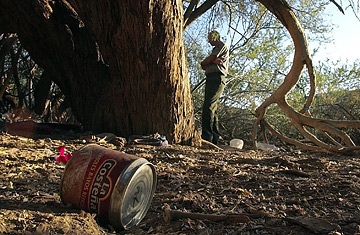
A park officer at Organ Pipe Cactus National Monument in southern Arizona stands among discarded water bottles, canned food and clothing at the base of an ironwood tree.
(2 of 2)
The federal government at least appears to understand that there has to be a delicate balance between the twin issues of security and the environment. "The solution has to vary location to location," Department of Homeland Security Secretary Michael Chertoff said last month to a room full of wary Texas landowners who fear access to Rio Grande water could be limited and border residents who have long viewed their Mexican neighbors (some of whom are family relatives) as friends and customers. "Obviously, at the end of the day, we have to make sure we can satisfy our operational requirements. But we want to be good neighbors and good partners."
But not everyone is confident that DHS will be so sensitive. At the eastern edge of the border, in the Lower Rio Grande Valley of Texas, where there has been a 30-year struggle to recover wildlife habitat from urbanization, ranching and agricultural clearing, over 95% of the native brush land has been erased. The area is home to a necklace of salvaged brush habitat known as the Lower Rio Grande Wildlife Refuge, 115 tracts along 70 miles of river front, purchased with $70 million in federal funds. "One of the ironies of this proposed fence is it flies in the face of 30 years investment in 100,000 acres on the border," said Carter Smith, head of the Texas Nature Conservancy. Some 82 miles of fence is supposed to be built along the river, which wildlife, ranchers and farmers have all depended on, and conservationists worry that fences would block access to water for dwindling species like the ocelot.
Two major flyways converge in the Lower Rio Grande Valley, bringing over 500 species of birds and 300 species of butterflies to the region, where eco-tourism is now a $150 million annual business. Hunters — including Vice President Dick Cheney — spend millions hunting white wing doves, which flourish in the brushy habitat. "This is the most biologically diverse region in North America," said Nancy Brown, public outreach officer for the refuge. This rich biodiversity has helped revive little border towns like Roma, a former river steamboat port, whose picturesque 19th century dusty plaza now boasts the World Birding Center. Looking down from the Roma Bluffs towards a large swath of brush near the international bridge, birders can watch four species of birds, including the Audubon oriole and the rare white-collared seedeater, not found elsewhere. Fears that the brush areas may have to be cleared to better secure the border is alarming Valley residents. "The outcry has been universal," Brown said.
The concern among Texas conservationists echoes a wider anxiety about "The Fence" along the Rio Grande, which has a long symbiotic relationship with Mexico. One environmental advisor to the Bush Administration who serves on a border issues panel established after NAFTA was passed told TIME there has been a "heartening response" in border communities to its recommendation that DHS conduct a national outreach program on the environmental and cultural impact of "The Fence." But, he adds, DHS is so focused on security that it has so far has failed to reach out adequately to both environmental groups and Mexican neighbors.
"The immigration issue can't be solved on the border," DiRosa said. "It has to be solved in Mexico City and Washington." He is encouraged by language in the current immigration bill that calls for DHS to comply with environmental standards and coordinate with various federal land management agencies to "minimize the adverse impact on natural and cultural resources from border protection activities."
"This is the best I've seen come out of Washington," DiRosa said in an e-mail to TIME after reading the bill. "Sounds good in theory, but then there is the real world in which we land managers and Border Patrol must work."
